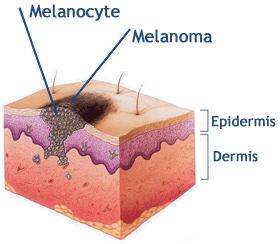
Who is at risk?
Anyone can get melanoma, but there are certain groups of people who have the following traits are at high risk:
- Those who have fair skin, especially if the person has red or blonde hair and green or blue eyes.
- Particularly common among Caucasians, especially northwestern Europeans living in sunny climates.
- Sun-sensitive skin, which rarely tans or burns easily
- With 50 plus moles, large moles or unusual-looking moles
- Had bad sunburns, spent time tanning either under the sun, sun lamps or tanning beds
- It runs in the family
- Has weakened immune system
Causes
The primary cause of melanoma is through the exposure of Ultraviolet (UV) radiation. UV radiation can be acquired through sun exposure, tanning beds or sun lamps. If you had a relative who has melanoma, you have a greater risk of getting one.
Signs and symptoms
Most often, melanoma develops in areas that have had exposure to the sun such as back, legs, arms and face. But melanoma can develop anywhere on your body. You can see if you have growing melanoma by the following signs known as ABCDE
- A is for asymmetrical shape. Check for irregularly shaped moles, such as two very different-looking halves
- B is for irregular border. Moles that have irregular, notched or scalloped borders
- C is for changes in color. Growths that have various colors or uneven distribution of color.
- D is for diameter. New growth in a mole larger than ¼ inch (about 6 millimeters)
- E is for evolving. If it changes over time, such as in size, color or shape.
You may also feel the following:
- Scaly skin
- Itching or tingling
- Tenderness
- Oozing or bleeding
Melanomas have these signs and symptoms, but not all. There are different types of melanoma which can first appear as a brown or black streak under a nail, or can look like a bruise that won’t heal.
Tests and Diagnosis
To determine if you have melanoma, or if you have found out the first signs of it, you will undergo different tests to diagnose or confirm your disease.
- Physical examination. You skin will be evaluated for melanoma. You will find suspicious growths that may be cancer or growths that may develop into skin cancer.
- Skin biopsy will be done. The doctor will remove a sample of skin tissue and will be looked under a microscope.
- Sentinel Lymph Node Biopsy (SLNB) may be done to stage the melanoma.
- Other tests may include x-rays, blood work, and a CT scan.
Treatment
The treatment of melanoma your doctor will give depends on the following:
- How deeply the melanoma has grown into the skin
- If it has spread to other parts of the body
- Your health
Melanoma may be cured if caught and treated early when it affects only the skin. If it is confined only to the skin, you will undergo surgery to remove it. Excision or the removal of the affected skin is the most effective treatment for melanoma. It can cure melanoma if it is thin and has not invaded the surrounding tissues. However, more treatment may be needed in more advanced stages or if the melanoma spreads to other organs.
- Chemotherapy uses drugs to destroy cancer cells. It can be given either intravenously, in pill form or both.
- Radiation therapy uses high-powered energy beams like X-ray to kill cancer cells.
- Immunotherapy boosts your immune system to help your body fight cancer.
Prevention
Preventing is better than curing melanoma. Exposure to ultraviolet radiation is the main cause so you there are tips to avoid them.
- Stop tanning
- Spend time outdoors when the sun is less intense
- Wear sunscreen with at least SPF 30
- Cover your skin with clothes, hats, etc
- Examine your skin every month
More post related:
First Aid Articles – Read here!
